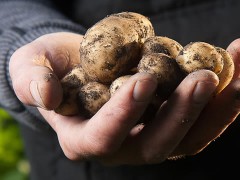My friend Matt is an aspiring farmer and student of environmental and agricultural law. He has farmed in his hometown of Cleveland, Ohio, as well as at farms in Lodi, New York, on farms all across Italy, and at the Finger Lakes Permaculture Institute, where he studied holistic landscape design for farms, gardens and communities. He now works for Fresh Picked Pantry, a start-up food processing venture which creates value added food products using only fresh, locally grown ingredients. His ultimate goal is to head back into the schoolhouse and get an environmental law degree so that he can continue to write and advocate for farmers, food entrepreneurs, and better food for everybody.
Matt was gracious enough to share his ideas on winter planning for small scale farm owners. Hit it, Matt:
As the snow falls and the fireplace crackles, quiet winter days offer many farmers the perfect opportunity to assess their farm business. What went well this past growing season? What didn’t go as planned? What were some of the challenges faced and overcome? A focused look back at both successes and areas in need of improvement can provide helpful insight for the coming year. Careful planning and timely restructuring are indispensable elements of any successful farm enterprise.
For meat and diary farmers, an anaerobic digester is a potential addition that can turn animal waste into free energy that can be used to power the farm and home. Digesters also alleviate groundwater contamination and reduce methane emissions, which could qualify a farmer for financial compensation in certain states. The startup costs of digesters has been fairly high in the past, but has decreased rapidly as more research has dedicated to digester design.
While major restructuring carries risks and management challenges, an approach geared toward a variety of small changes can have a powerful impact on the farm’s bottom line. For example, replacing aging equipment or vehicles provides the added benefit of tax write-offs for investments. Identifying better equipment can also significantly reduce costs in the long run. One example might be a new seeding implement that improves the accuracy of seed placement, thus reducing the cost of labor (for thinning) and seed. Whatever you decide to replace or repair, contact your accountant – one who is familiar with agricultural businesses – and inquire about the specific tax advantages of upgrading your equipment.
Take some time to identify opportunities to grow new products. Reflect on what products you saw offered by other farms in your area. Talk to some chefs or local food entrepreneurs to find out what ingredients they are dying to use but cannot procure locally. Suppose the local farmer’s market has become flooded with organic vegetable producers, but there is a lack of fruit or mushrooms available. It might be worthwhile for a vegetable producer to consider diversifying the farm by adding a mushroom yard to a forested area of the property or using a few rows the following season to plant strawberries and raspberries instead of cabbage. Startup costs for both of these additions are low, yet each could fetch a high price at the market due to their limited supply.
Farmers can also use the idle time of winter to seek out and forge relationships with small food producers, restaurants and other potential wholesale clients as a source of supplemental or primary income depending on the business model of the particular farm. Fortunately for small scale farmers, demand for local products is steadily increasing, and there are ready-made markets for farmers to tap into in just about every region of the country. The key is to cross-promote each other’s products – get the name of your farm on the menu or on the label, and make sure you do the same for them.
Grants and low-interest loans through the state and federal government, as well as non-profit organizations, are well worth looking into. Beginning farmers, in particular, have many such opportunities available to them. Beginningfarmers.org (a great friend of this food law blog), is a great resource for funding opportunities. Also check out the National Center for Appropriate Technology, which has another great funding page.
The opportunity for creativity in a farming venture is endless, whether in the fields or the office. That’s what makes it fun. And the bottom line here is that wintertime presents a prime opportunity for farmers to be creative with their business in order to ensure that they remain thriving for years to come.

















